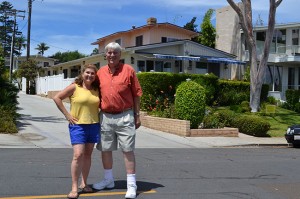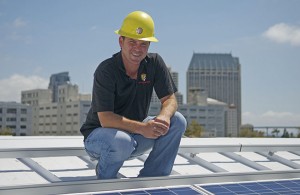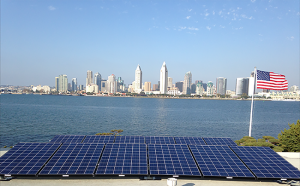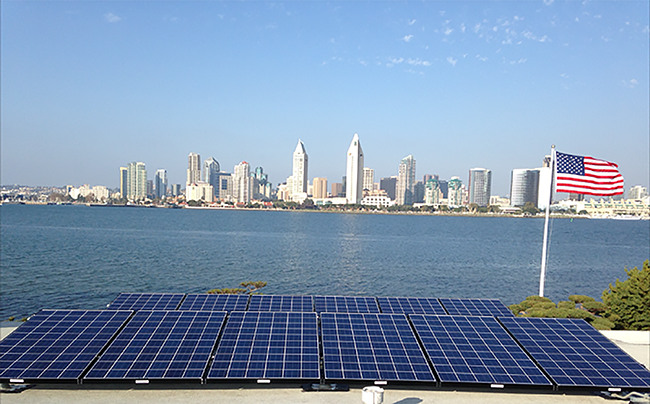It’s been almost five years since Rob and Mary Taylor had solar panels installed on the roof of their guesthouse on Glorietta Boulevard. After federal and state rebates and their annual savings on San Diego Gas and Electric bills, their system will be paid off within another two years. Then it’s pure savings for years to come.
But the Taylors are adamant that saving money, while a nice perk, wasn’t what drove their decision to install solar.
“We just knew it was the right thing to do in a place like Coronado,” said Rob Taylor. “You have the sun beating down on your roof every day. It makes your house hot and it’s going to waste. If you can convert it to help power your house, you’re living more lightly off the grid of society. There’s more electricity for somebody else who really needs it.”
Adds Mary Taylor, “We did it because we believe the power from the sun is the one energy source that will only increase as compared to the rest of the earth’s resources that will only decrease.”
The technology behind solar electric is commonly referred to as photovoltaics, whereby solar “cells” are absorbed into solar panels that convert sunlight directly into electricity. This energy can be used to charge anything that requires power, from batteries and lamps to cars and satellites.
The dramatically escalating numbers reflect the popularity of solar throughout the region. In a nationwide survey of solar energy installations among 50 U.S. cities conducted last April by the nonprofit Environmental California Research & Policy Center, San Diego ranked second, overshadowed only by Los Angeles.
It’s no accident that solar panels are beginning to blanket California rooftops: state regulations require that 25 percent of California’s electricity come from renewable resources by 2016, and 33 percent by 2020. Solar’s emergence was spurred on by the California Solar Initiative, adopted during Arnold Schwarzenegger’s term as governor, that called for installation of solar systems on 1 million new and existing homes between 2007 and 2016. The program came with a $2.167 billion budget and a goal to install approximately 1,940 megawatts of solar generation capacity.
According to California Solar Initiative data, Coronado only had 19,604 watts of solar installed by the end of 2007, but in the last seven years, the amount of solar produced — almost all of it by residents — has totaled 732,501 watts.
By far the largest installer of solar in Coronado is San Diego-based Sullivan Solar Power. Dan Sullivan launched the company to take advantage of the first major rebate program offered by the California Energy Commission. “I saw that San Diego had excellent potential, and I used my experience as a foreman at a commercial electrical contractor,” said Sullivan, a former Coronado resident. The company has installed more than 18½ million watts of solar systems throughout Southern California, ranging from residential to large-scale commercial and municipal systems.
The company’s website (sullivansolarpower.com) includes a portfolio of rooftops in the Southern California communities it services; Coronado has 35 rooftops featured with last names of residents listed.
Most solar systems installed in Coronado average about 3 kilowatts, (ranging from 1 to 5 kilowatts to date) and have ranged in price from approximately $16,000 to $55,000, said a company representative with Sullivan Solar. The range can fluctuate based on the square footage and configuration of the home, as well as its energy consumption history, often relating to the number and lifestyle of the occupants.
Many customers install solar panels to place their energy consumption in one of San Diego Gas & Electric’s lower tiers, said Stephanie Donovan, a spokeswoman for the utility. SDG&E’s tiered system based on energy consumption includes two lower tiers charging 16 and 18 cents per kilowatt. But the third and fourth tiers spike up dramatically to 35 and 37 cents per kilowatt. “It’s up to the customers to do their due diligence in sizing their system correctly,” Donovan advised.
The Taylor family’s solar system cost about $25,000. They received about 30 percent of that total, about $7,500, back from the federal government the following April as a tax credit. “We had a choice of two options from the state,” explained Rob Taylor. “One was a 20 percent rebate, but that would have reduced our federal rebate. The second option, which we took, was a savings of 22 cents per kilowatt hour, stretched over five years.”
Today, state rebates have dried up (except for some commercial and educational complexes) but federal rebates remain intact — at least through the end of 2016, and consumers who install solar up to that point will be able to enjoy the rebates each year on their system. Recent legislation has guaranteed that consumers will continue to receive credits for at least 20 years from the power they put back into the electrical grid.
The Taylors now pay just one annual bill to SDG&E. “Last March I wrote a check for $1,200 and the year before for $1,000,” said Rob Taylor. Those totals covered the annual energy for a 3,300-square-foot main house and guesthouse, occupied by three people year-round and additional occupants in the summer months.
Terry Player installed solar through Sullivan Solar at her home near Sharp Coronado Hospital in February 2009.
Like the Taylors, she wasn’t motivated by saving money as much as reducing her carbon footprint. “I’ve always been interested in all the ways I can conserve energy,” said Player, a professor of law at the University of San Diego. “I’m a person who has always recycled. And I realize I’m better off than most people. I told myself I could afford to do this, I should do this, and so I did.”
A nice bonus was that the first summer after she installed solar, Player’s electrical bill was $5, “and that was just for the processing fee,” she added.
Gus and Janice Brummond paid $22,000 for the solar system installed 4½ years ago at their home in the Coronado Cays. The first year they recouped about $11,000 from federal and state tax credits. “I estimated it would take about eight years to break even,” said Gus Brummond. “But now, it looks like it will be closer to six.”
Both retired schoolteachers who taught science for much of their careers in National City and the South Bay, the Brummonds are passionate champions of solar.
“If everybody would go solar we would be less dependent on other countries for oil and energy sources,” Gus Brummond said. He noted that his sister, who lives about five houses down the street in the Cays, has installed solar, as has his daughter, who lives in Lemon Grove.
The Brummonds had 14 solar panels installed; Sullivan representatives helped them calculate how large a system they would need. “They’ll take your usage from the last year or two and base the system on that,” Brummond said.
Meanwhile, a new financing alternative will soon be available to Coronado homeowners. Joining 13 other cities in the county, Coronado is adopting the Property Assessed Clean Energy (PACE) financing program, called HERO, at the end of this year. This program will allow Coronado property owners to repay loans for solar installation through their property taxes, a financing program based on the equity in a home and mortgage payments rather than credit scores.




